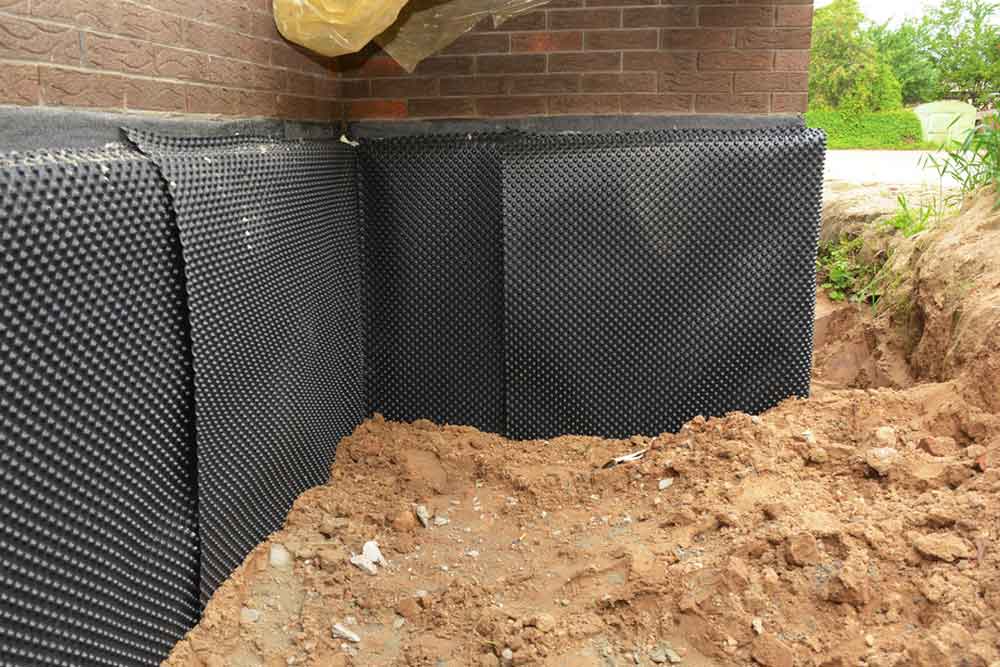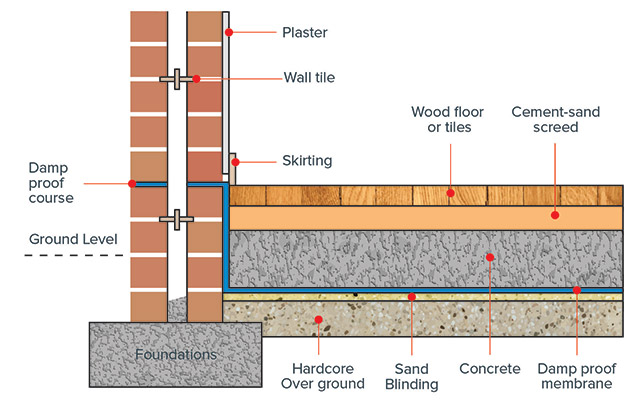Understanding the Significance of Damp Proofing in Averting Structural Damages
Wet proofing acts as a vital defense against moisture infiltration in buildings. This protective step can stop considerable architectural damage, yet many building owners stay unaware of its value. Identifying the indicators of moisture and comprehending the different remedies available can be essential. Nonetheless, ignoring wet proofing can cause serious effects. What are the specific threats and remedies that building owners should consider?
What Perspires Proofing and Exactly How Does It Work?
Wet proofing acts as an important barrier versus wetness invasion in structures. damp removal newcastle. This process includes using certain products and strategies to stop water from penetrating wall surfaces, floors, and other architectural aspects. Generally, moist proofing can be achieved via the installment of moist proof membranes, finishings, or making use of specialized sealants.These techniques work by producing a protective layer that hinders dampness activity, guaranteeing that the indoor atmosphere remains healthy and balanced and dry. Damp proofing is specifically essential in locations susceptible to high moisture or groundwater, as it aids keep the integrity of the structure over time.Moreover, reliable damp proofing adds to energy efficiency by stopping warm loss connected with wet atmospheres. By dealing with potential moisture problems prior to they rise, damp proofing offers as a positive action in guarding structures from the harmful results of water damage, inevitably lengthening their life expectancy and keeping their value
Common Indications of Wetness in a Structure
Moisture issues within a building can show up with several noticeable signs that suggest the visibility of wetness. One noticeable indicator is the look of water discolorations on ceilings or wall surfaces, which commonly shows wetness infiltration. In addition, peeling off or gurgling paint can recommend that excess moisture is entraped beneath the surface area, leading to deterioration. One more common sign is the presence of mold and mold, which grow in damp conditions and can typically be recognized by their stuffy odor. Additionally, an increase in moisture levels can trigger condensation on home windows and various other surfaces, highlighting moisture problems. Unequal or deformed floor covering may signify underlying wetness that jeopardizes structural stability. Acknowledging these indications early can help alleviate potential damages and preserve a risk-free living setting. Normal assessments and punctual action are essential in dealing with dampness issues prior to they escalate.
The Threats of Neglecting Damp Proofing
Disregarding wet proofing can result in significant threats to a building's structural honesty, as dampness accumulation may compromise foundations and walls. Additionally, long term moisture produces an atmosphere for mold development, posturing significant wellness threats to occupants. Addressing these risks is crucial for guaranteeing both safety and security and longevity of the building.
Structural Stability Hazards
When homeowners ignore the value of efficient damp proofing, they subject their properties to considerable structural integrity risks. Long term dampness infiltration can bring about the advancement of mold, which damages fundamental elements and can jeopardize general stability. Additionally, excess dampness can erode concrete and brickwork, resulting in cracks and architectural failures. Wood components are especially susceptible; they can rot and shed load-bearing ability, presenting serious dangers to the structure's structure. Without treatment damp problems might bring in parasites, such as termites, which better worsen structural deterioration. Eventually, disregarding wet proofing procedures can cause expensive repair work and prospective security dangers, underscoring the necessary duty of proactive damp monitoring in protecting the honesty of properties.
Carcinogen Issues
How can a relatively minor oversight bring about severe health risks? Overlooking wet proofing can produce a setting for mold and mildew development, which postures substantial health risks. Mold and mildew spores can activate sensitive responses, breathing concerns, and various other wellness problems, specifically in prone populations such as children, the senior, and people with pre-existing problems. Additionally, persistent wetness can attract pests like rodents and insects, which carry conditions that additionally endanger health and wellness. The existence of dampness also adds to a decline in indoor air quality, intensifying bronchial asthma and other breathing ailments. The failure to address wet problems not just intimidates architectural integrity however also endangers the health of occupants, highlighting the crucial need for reliable wet proofing measures.
Various Kinds of Damp Proofing Solutions
Different variables can add to damp issues in structures, choosing the appropriate damp proofing solution is vital for maintaining structural honesty. Numerous choices are offered, each tailored to particular conditions.One usual option is a damp-proof membrane layer (DPM), generally made from polyethylene or asphalt, which is mounted in floorings and walls to stop dampness access. An additional option is damp-proof courses (DPC), which are layers of water resistant product positioned within wall surfaces to block climbing damp.Chemical damp proofing includes injecting waterproofing chemicals into wall surfaces to develop an obstacle versus wetness. Furthermore, exterior treatments such as tanking, which includes using a water resistant layer to the beyond foundations, can be efficient in avoiding water penetration.Each option has its advantages and is selected based on the structure's particular problems, ecological conditions, and lasting upkeep considerations, guaranteeing optimal defense versus damp-related damages.

The Expense of Damp Damage vs. Prevention
Recognizing the economic effects of damp damage compared to avoidance highlights the relevance of proactive measures. The costs related to moist damages can be substantial, including fixings to structural components, mold remediation, and potential health-related costs. House owners may deal with considerable monetary strain if extensive damage occurs, leading to boosted insurance costs and lost property value.In comparison, investing in damp proofing services is usually much more economical. Initial costs for prevention techniques, such as boosting or installing damp-proof membranes drain systems, are usually exceeded by the lasting financial savings from preventing pricey repair services. In addition, avoiding damp problems can boost a residential or commercial property's overall value and allure, making it a wise investment. When examining the expense of damp damage versus avoidance, it ends up being clear that taking positive steps can secure financial rate of interests and keep the integrity of the residential or commercial property gradually.
Picking the Right Damp Proofing Method for Your Home
Which wet proofing approach is most appropriate for a details residential or commercial property commonly depends on different factors, consisting of the building's age, existing moisture problems, and neighborhood ecological conditions. For older structures, conventional methods such as asphalt membranes or cementitious finishes might be more effective, as they can provide a durable barrier against rising wet. In comparison, newer buildings might profit from modern-day remedies like injected damp-proof training courses, which are much less invasive and can be tailored to details wetness challenges.Additionally, homes in areas with high water tables or heavy rains might call for even more innovative methods, such as tooth cavity wall water drainage systems or check here exterior waterproofing. House owners ought to likewise consider the certain materials utilized in their structure's building and construction, as some techniques might not work. Eventually, a thorough assessment by an expert can lead residential or commercial property owners in choosing the most effective damp proofing approach tailored to their one-of-a-kind circumstances.
Keeping Your Damp Proofing System With Time
Normal upkeep of a damp proofing system is necessary for guaranteeing its lasting efficiency and protecting a property from moisture-related damage. Homeowner must perform routine assessments to identify any type of indications of wear or concession in the moist proofing layer. This includes monitoring for splits, peeling off paint, or mold and mildew growth, which might show wetness intrusion.Additionally, it is a good idea to tidy rain gutters and downspouts on a regular basis to avoid water accumulation around the structure. If deterioration is observed.Engaging specialist services for periodic evaluations can better enhance the sturdiness of the system, reapplying membranes or sealers might be needed. These specialists can give understandings right into prospective susceptabilities and recommend prompt repair work.
Frequently Asked Concerns
Just How Long Does Damp Proofing Therapy Last Prior To Needing Repairs?
The durability of wet proofing treatment normally varies from 10 to three decades, depending on aspects such as the method made use of, ecological problems, and maintenance practices. Regular examinations can aid identify when fixings might be needed.
Is Do It Yourself Damp Proofing Effective Contrasted to Professional Providers?
The performance of DIY wet proofing differs substantially. mould treatment newcastle. While some people may attain satisfying results, professional solutions commonly guarantee thorough services, leveraging knowledge and high quality products to stop future concerns extra dependably than a lot of do it yourself efforts
Can Damp Proofing Improve Indoor Air High Quality?
The inquiry of whether moist proofing can improve indoor air top quality develops regularly. Efficient damp proofing minimizes moisture levels, therefore reducing mold and mildew growth and allergens, ultimately contributing to a healthier interior setting for occupants.
Are There Details Regulations for Damp Proofing in Different Areas?
Regulations for wet proofing vary by region, usually affected by neighborhood building ordinance and ecological problems. Compliance warranties reliable moisture control, guarding frameworks and promoting safety and security, which highlights the need for adherence to these certain laws.

What Are the Long-Term Perks of Appropriate Damp Proofing?
The long-lasting benefits of proper moist proofing include boosted architectural stability, decreased maintenance expenses, enhanced indoor air top quality, and boosted property value. These benefits add to a healthier living environment and long term lifespan of structures. Usually, moist proofing can be accomplished through the installation of damp evidence membranes, coverings, or the use of specialized sealants.These approaches function by creating a protective layer that prevents dampness motion, making certain that the indoor atmosphere stays healthy and completely dry. Damp proofing is especially essential in areas susceptible to high moisture or groundwater, as it helps preserve the honesty of the framework over time.Moreover, efficient wet proofing adds to energy effectiveness by protecting against warm loss connected with moist environments. Disregarding damp proofing can lead to significant risks to a structure's architectural honesty, as dampness build-up might deteriorate structures and wall surfaces (mould treatment newcastle). Numerous aspects can contribute to damp issues in structures, picking the ideal damp proofing remedy is essential for protecting structural stability. Which wet proofing method is most appropriate for a certain building typically depends on various variables, including the structure's age, existing dampness issues, and local ecological conditions
Comments on “Addressing condensation problems permanently with mould treatment newcastle”